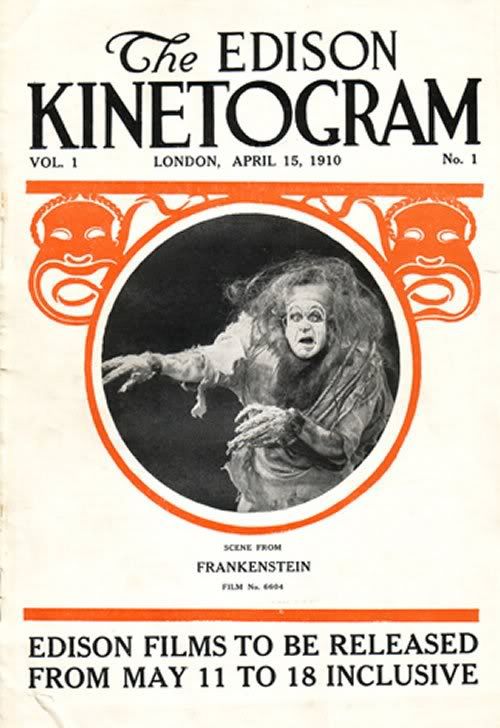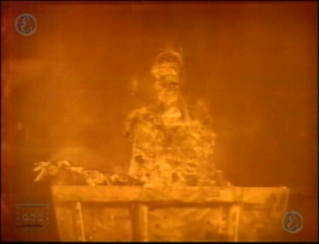I intended to get this up during the day today so those of you who read during the workday would have a little something extra to get you over the hump, but life kinda got in the way of that today. Still, a few hours late ain't too bad! Today, we'll be looking at a film that was once considered lost, 1910's Frankenstein!
Thomas Edison's film company produced hundreds of films, most of which clocked in around the ten-minute mark. Frankenstein was no exception, running about 13 minutes. The film was shot in three days by director J. Searle Dawley at Edison's New York film studio in the Bronx.
Young Dr. Frankenstein(Augustus Phillips) departs for college, leaving his father and fiancee(Mary Fuller) behind. Frankenstein becomes obsessed with discovering the secrets of life and death. His ambition is to create the perfect human being, but the fruit of his labors is a horrific creature(Charles Ogle) that threatens all that Frankenstein holds dear.
None of the actors' careers survived the silent era. (Fuller, in particular, had a tragic life.) Ogle makes a distinct impression as the Monster, even with his limited screentime. The Monster makeup, which Ogle reportedly designed himself, has a design which has echoed through the decades in many of the Frankenstein Monster designs we've seen in all the years since. Most notably, the Monster's large, square forehead is one of the physical traits most strongly-identified with the Frankenstein Monster in pop culture. (It seems nearly impossible that Jack Pierce wasn't partially inspired by the Ogle Monster when designing Boris Karloff's makeup for Universal's version of Frankenstein in 1931. This is just conjecture, however.) The visually intriguing creation sequence, which must have absolutely floored audiences at the time, was accomplished through the use of a papier mache figure of the Monster. The figure was burned, and the footage was shown in the reverse in the film, so the Monster appears to be growing from the ether.
As mentioned previously, the film was believed lost for decades until its rediscovery in the 1970s. A print had been purchased by a film collector in the '50s, who revealed its existence after he became aware of its rarity. A new 35MM print was made, and the film has since been given a DVD release.
Although it jettisons nearly everything from the source novel, Frankenstein remains the first film adaption of the famous story. The film feels rather stagebound, as only a couple of sets are seen; this was typical of many films of the era(when outdoor locations were not utilized, small sets were used instead). Today, it's probably more of a cinematic curiosity than genuine entertainment for most people, but what a curiosity it is! Frankenstein remains a landmark in film history, particularly for the horror genre. With its brief running time, and its status as a public domain film that is easily found on sites like Youtube, there's no reason not to watch it. In this film, you will see the embryonic form of one of the most enduring icons of our culture.







No comments:
Post a Comment